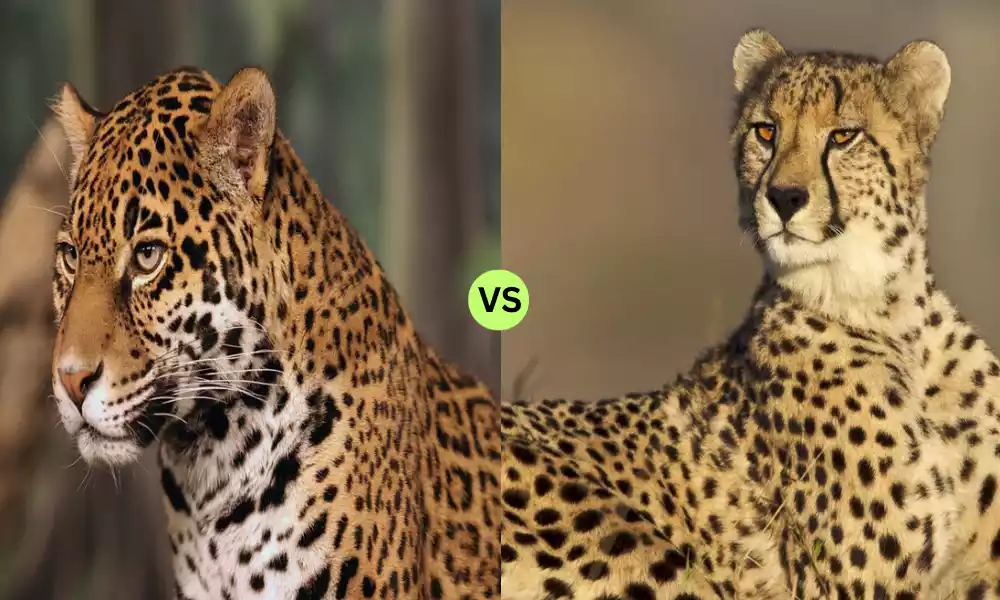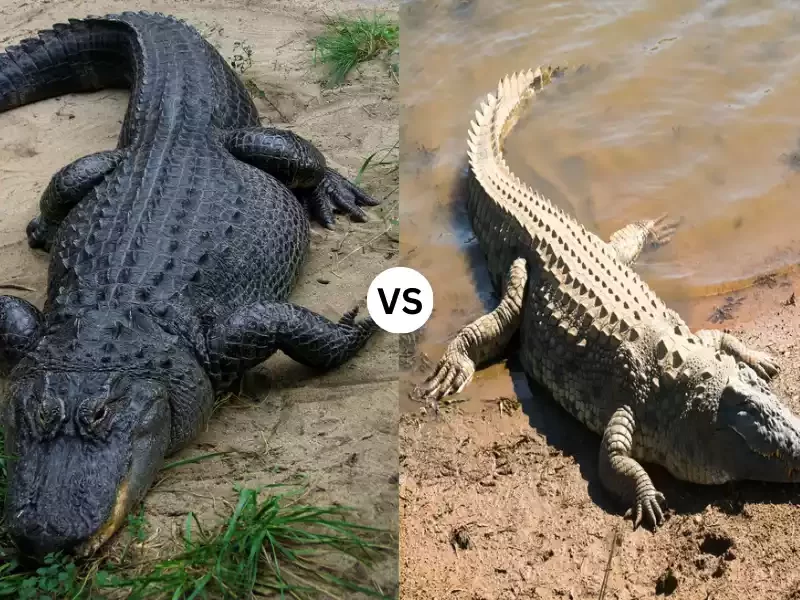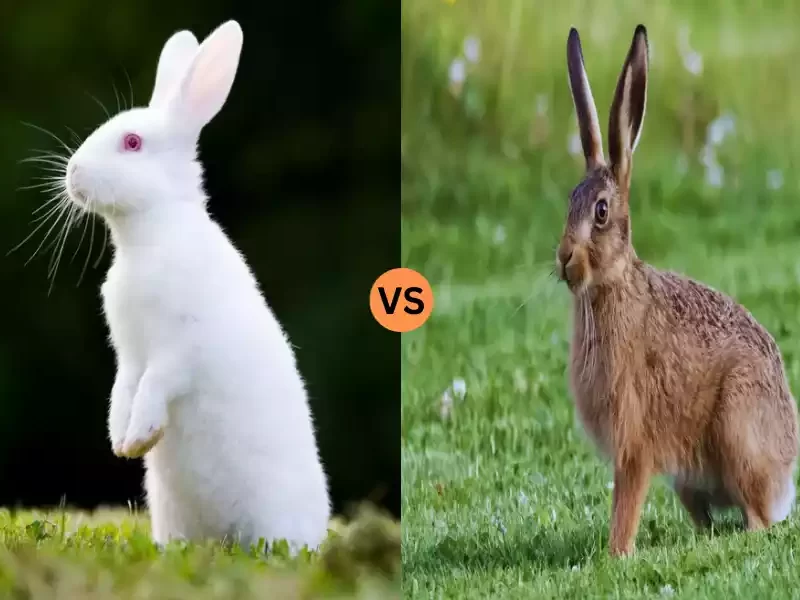Introduction
Jaguar and Cheetah are two of the most iconic wild cats in the world, each possessing unique attributes that distinguish them from other felines. The jaguar, native to the Americas, is renowned for its powerful build and beautiful rosette-patterned coat, often found in dense jungles and swamplands. It is the third-largest big cat globally and is especially noted for its strength and swimming abilities. On the other hand, the cheetah, indigenous to parts of Africa and a small population in Iran, is recognized for its slender frame and distinctive tear marks that run from its eyes to the sides of its nose.
It is celebrated as the fastest land animal, capable of reaching speeds up to 58-64 mph in short bursts covering distances up to 1,500 ft. While both cats are apex predators in their respective habitats, they have evolved with distinct features and abilities that suit their environments and prey preferences.
Definition of Jaguar
The jaguar (Panthera onca) is a large felid species and the only extant member of the genus Panthera native to the Americas. It is the third-largest big cat in the world, after the tiger and lion, and is known for its powerful build, deep chest, and short legs. The jaguar’s coat is typically tawny yellow and is marked with rosettes, which are dark, ring-like patterns that often have a spot in the center. Jaguars are renowned for their strength and agility, with a strong preference for riverine habitats. They are adept swimmers and often hunt in water.
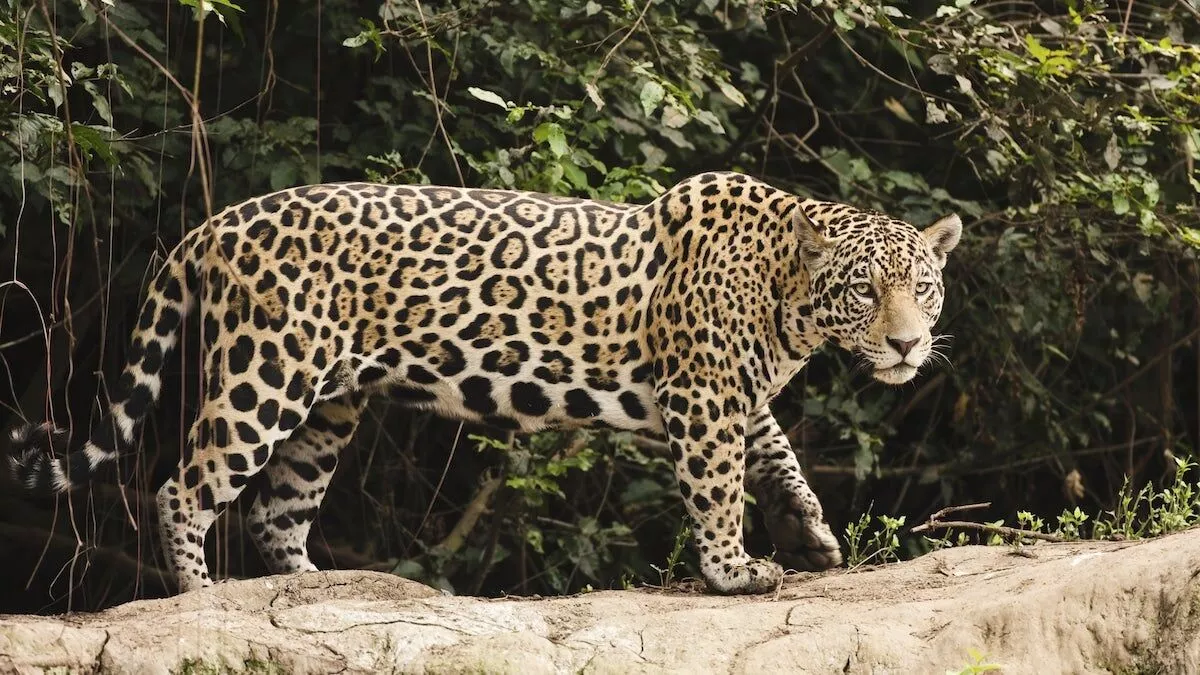
Historically, they have been found from the southern United States through Central America to South America, with the Amazon rainforest being a significant habitat. The jaguar is an apex predator, often hunting by ambush and possessing a particularly powerful bite that allows it to pierce the skulls or shells of its prey.
Definition of Cheetah
The cheetah (Acinonyx jubatus) is a large felid known for its incredible speed, making it the fastest land animal. Native primarily to African savannahs and open grasslands, it possesses a slender, aerodynamic body built for rapid acceleration and short sprints. Distinctively, the cheetah has small, round black spots on its light golden-yellow coat and characteristic ‘tear marks’ that run from the inner corners of its eyes down to the sides of its mouth. These marks help reduce glare from the sun and focus better on prey.
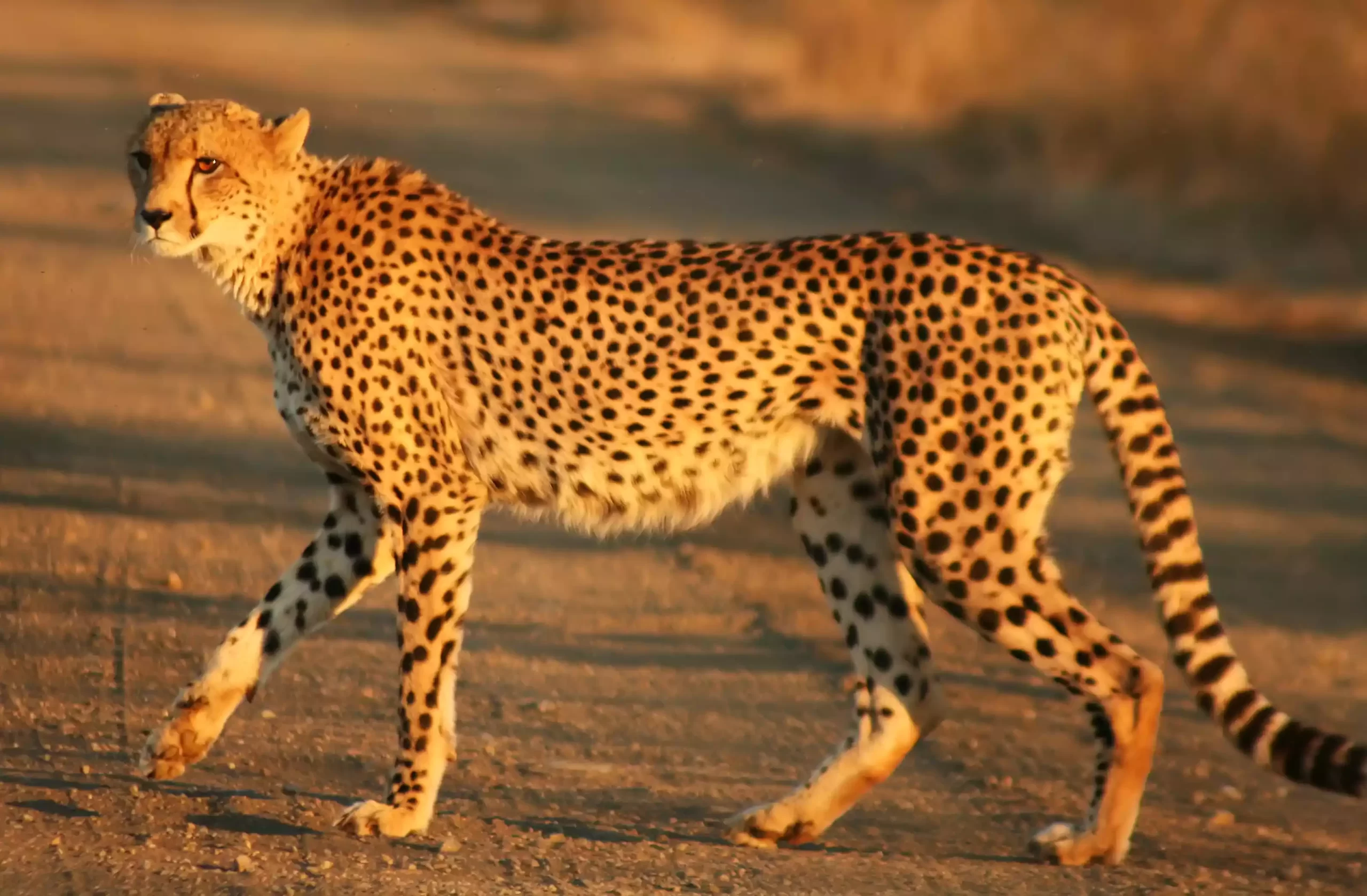
Unlike other big cats, cheetahs cannot roar but produce a variety of other vocalizations including chirps, purrs, and hisses. Their non-retractable claws and specialized pads provide better grip during their high-speed chases. While adept hunters, their lightweight build means they often have their kills stolen by larger predators.
Comparison Table of Jaguar and Cheetah
There are Comparison Table of Jaguar and Cheetah:
| Feature/Aspect | Jaguar | Cheetah |
|---|---|---|
| Scientific Name | Panthera onca | Acinonyx jubatus |
| Native Habitat | Americas (from U.S. to South America) | Primarily Africa, some in Iran |
| Preferred Environment | Dense forests, swamps, grasslands | Open plains, grasslands |
| Physical Build | Robust, powerful | Slender, built for speed |
| Weight | Males: 126-250 lbs; Females: 100-200 lbs | Males: 110-140 lbs; Females: 88-115 lbs |
| Coat Pattern | Rosettes (spots inside) | Small round black spots |
| Distinctive Features | Broad head, powerful jaw | ‘Tear marks’ on face, non-retractable claws |
| Hunting Time | Often nocturnal | Diurnal (daytime hunter) |
| Speed | Around 50 mph (short distances) | Up to 58-64 mph (short sprints) |
| Diet | Varied (deer, peccaries, capybaras, etc.) | Primarily ungulates (gazelles, impalas, etc.) |
| Vocalizations | Growls, roars | Chirps, purrs, hisses |
| Social Behavior | Largely solitary, territorial | Females solitary; males form coalitions |
| Conservation Status | Near Threatened | Vulnerable |
The figures, especially weight and speed, are approximations and can vary based on different sources and specific subspecies.
Physical Appearance
Certainly, let’s delve deeper into the physical appearance of both the jaguar and the cheetah:
Jaguar:
- Size and Build: Jaguars are robust and have a powerful build, making them the third-largest big cat species in the world after tigers and lions. Adult jaguars typically weigh between 100 to 250 lbs, depending on gender and region.
- Coat Pattern: Their coat is primarily a tawny yellow, but can range to reddish-brown and even black. What distinguishes them are the larger rosettes – patterns resembling roses – which have smaller spots inside. These rosettes are unique to each individual, much like a human’s fingerprints.
- Facial Features: Jaguars possess a broad head with powerful jaws. Their eyes are set closer to the nose compared to other big cats. Unlike cheetahs, they don’t have tear marks on their faces.
- Legs and Paws: They have relatively shorter, muscular legs which are suited for ambushing prey rather than long chases. Their paws contain retractable claws which are kept sharp for hunting.
Cheetah:
- Size and Build: Cheetahs have a slender and lightweight build tailored for speed. Adult cheetahs generally weigh between 88 to 140 lbs. They have a small head relative to their body and a unique aerodynamic structure.
- Coat Pattern: Their coat is a light golden-yellow adorned with distinct small round black spots. This pattern provides them with some camouflage while stalking prey in the grasslands.
- Facial Features: One of the most recognizable features of a cheetah is the black ‘tear marks’ that run from the inner corners of its eyes down to the sides of the mouth. These marks help to focus better on prey and reduce glare from the sun.
- Legs and Paws: Cheetahs have longer legs designed for sprinting. Their non-retractable claws provide additional grip during high-speed pursuits. The pads of their feet are hard, similar to tire treads, to help them maintain traction while running.
Both these big cats are marvels of evolution, each adapted perfectly to their respective lifestyles and habitats. While the jaguar is the embodiment of raw power and stealth, the cheetah is the epitome of speed and agility.
Habitat and Distribution
The habitat and distribution of a species can provide significant insights into its ecological preferences, behavior, and evolution. Here’s a breakdown of the habitat and distribution of both the jaguar and the cheetah:
Jaguar:
- Habitat: Jaguars prefer a variety of habitats, but they are most commonly associated with riverine forests, swamps, grasslands, and tropical rainforests. They are adept swimmers and often choose habitats near water sources.
- Distribution: Historically, jaguars ranged from the southwestern United States to the southern tip of South America. Their range has significantly reduced over time due to habitat loss and other threats. Today, they are mainly found in:
- Central America: Countries like Belize, Guatemala, and Costa Rica.
- South America: The Amazon Basin remains a significant stronghold for the species, with countries like Brazil, Bolivia, and Peru having notable populations. Other countries include Argentina, Paraguay, and Colombia.
Cheetah:
- Habitat: Cheetahs are predominantly found in open plains and grasslands. They prefer habitats where they can utilize their incredible speed without many obstructions. Semi-desert regions, savannahs, and scrub forests also provide suitable habitats.
- Distribution: The vast majority of the world’s cheetah population is found in Africa, with a tiny fraction in Iran. Their distribution includes:
- East Africa: Countries such as Kenya and Tanzania.
- Southern Africa: Botswana, Namibia, and parts of South Africa.
- North-East Africa: Small populations might be found in countries like Ethiopia and Somalia.
- West Africa: Their population here is limited and fragmented, with Niger being one of the last strongholds for West African cheetahs.
- Asia: The Asiatic cheetah, a subspecies, is critically endangered and is currently found only in parts of Iran.
The habitats and distributions of both these species have faced challenges due to factors like habitat fragmentation, human-wildlife conflict, and poaching. Conservation efforts are ongoing to protect and preserve the remaining populations of both jaguars and cheetahs.
Behavior and Lifestyle
Understanding the behavior and lifestyle of a species is essential for insights into its ecology, reproductive strategies, and interaction with its environment. Here’s a breakdown of the behavior and lifestyle of both the jaguar and the cheetah:
Jaguar:
- Hunting Techniques: Jaguars are ambush predators, often lying in wait or stalking silently to get close to their prey before launching a rapid attack. Their strong jaw muscles allow them to employ a unique killing method: piercing directly through the skull of their prey, between the ears.
- Dietary Habits: Jaguars are opportunistic predators with a varied diet. They hunt a range of animals, from deer and peccaries to birds, fish, and even caimans in water.
- Activity Pattern: They are primarily crepuscular (most active during dawn and dusk) but can also be nocturnal.
- Social Behavior: Jaguars are largely solitary animals. They mark their territory with scent markings and scrape marks. Males have larger territories that often overlap with those of multiple females.
- Vocalizations: Jaguars communicate through growls, chuffs, and roars, especially during mating seasons.
Cheetah:
- Hunting Techniques: Cheetahs hunt primarily by sight, spotting their prey from a distance and stalking closely before launching into a high-speed chase. These sprints are short-lived, typically lasting only about 20-30 seconds, due to the immense energy required.
- Dietary Habits: Cheetahs mainly prey on medium-sized ungulates, such as gazelles and impalas. They also hunt smaller mammals and birds if the opportunity arises.
- Activity Pattern: Cheetahs are diurnal, which means they are active mainly during the day, especially during early morning and late afternoon when temperatures are cooler.
- Social Behavior: Female cheetahs are generally solitary, especially when raising cubs. Male cheetahs, on the other hand, often form groups called coalitions, usually consisting of brothers from the same litter. These coalitions help in securing territories and fending off other males.
- Vocalizations: Unlike most big cats, cheetahs cannot roar. Instead, they communicate through a series of vocalizations like chirps, purrs, hisses, and moans.
While both the jaguar and cheetah are apex predators in their respective habitats, their behaviors and lifestyles differ significantly due to their unique evolutionary adaptations and environmental interactions.
Reproduction and Lifespan
Reproduction and lifespan are pivotal aspects of an animal’s biology, providing insights into its evolutionary strategies, population dynamics, and conservation needs. Let’s examine these aspects for both the jaguar and the cheetah:
Jaguar:
- Mating Behavior: Jaguars are solitary animals, and males and females usually come together only for mating. They communicate their readiness to mate through vocalizations and scent markings.
- Gestation and Offspring: After mating, the female has a gestation period of about 90-110 days. She will give birth to a litter of one to four cubs, though two to three is most common. Cubs are born blind and rely entirely on their mother for the first few weeks.
- Parental Care: The mother raises the cubs alone, teaching them to hunt and survive in the wild. By the age of two, most young jaguars will leave their mother to establish their own territories.
- Lifespan: In the wild, jaguars typically live for 12-15 years, although they can live slightly longer in captivity.
Cheetah:
- Mating Behavior: Female cheetahs are solitary and will seek out males when in estrus. Males, especially those in coalitions, will establish territories and mate with females that enter their domain.
- Gestation and Offspring: After mating, the gestation period for cheetahs is approximately 90-95 days. The female gives birth to a litter of three to five cubs on average, but it can be as many as eight.
- Parental Care: The mother finds a secluded spot to give birth and keeps the cubs hidden for the first few weeks. As with jaguars, the mother is solely responsible for raising and teaching the cubs. Cubs will stay with their mother for about 18 months to learn essential survival skills.
- Lifespan: Cheetahs live around 8-12 years in the wild. In captivity, with the absence of predators and regular medical care, they can live up to 15 years or slightly more.
For both species, reproduction is affected by factors like habitat loss, human-wildlife conflict, and poaching. Efforts are in place to ensure that these magnificent animals continue to thrive in their natural habitats.
Conservation Status
Conservation status provides a snapshot of how a particular species is faring in the wild and the urgency of conservation actions needed to protect them. Let’s review the conservation status of both the jaguar and the cheetah:
Jaguar:
- Status: As of the last update (from my last training data up to January 2022), the International Union for Conservation of Nature (IUCN) Red List categorizes the jaguar as “Near Threatened.”
- Threats: Jaguars face multiple threats, including:
- Habitat Loss: Conversion of forests for agriculture, logging, and human settlements results in shrinking habitats for jaguars.
- Human-Wildlife Conflict: As their natural prey becomes scarcer due to habitat changes, jaguars might prey on domestic livestock, leading to retaliatory killings by humans.
- Poaching: Jaguars are hunted for their beautiful pelts, and body parts are sometimes used in traditional medicines.
- Conservation Efforts: Various efforts are being made to protect jaguars:
- Creation and management of protected areas that serve as sanctuaries for jaguars.
- Corridor projects that link fragmented habitats, allowing for gene flow between jaguar populations.
- Public awareness campaigns to reduce human-wildlife conflicts and encourage coexistence.
Cheetah:
- Status: The IUCN Red List categorizes the cheetah as “Vulnerable.” However, some specific populations, like the Asiatic cheetah, are critically endangered with only a few individuals remaining.
- Threats: Cheetahs face several threats, including:
- Habitat Loss: Expansion of agricultural lands, human settlements, and infrastructure developments reduces available habitats for cheetahs.
- Human-Wildlife Conflict: Similar to jaguars, cheetahs sometimes prey on domestic livestock, leading to conflicts with farmers.
- Poaching: Cheetah cubs are especially vulnerable to being captured for the illegal pet trade.
- Reduced Prey: Overhunting and habitat degradation have reduced the number of prey available to cheetahs.
- Conservation Efforts: Various initiatives are in place to protect cheetahs:
- Establishment of protected areas and reserves.
- Rehabilitation and release programs for confiscated or injured cheetahs.
- Community-based conservation projects to involve local communities in cheetah conservation.
- Educational and awareness campaigns targeting both local communities and broader audiences.
It’s essential to understand that while both species face threats, conservation status can change based on ongoing conservation efforts, changes in threats, and new population assessments. Continuous monitoring and updated research are vital to keep abreast of their current status and needs.
Hunting Techniques
Both jaguars and cheetahs have evolved specific hunting techniques tailored to their respective environments, strengths, and prey.

Let’s explore these techniques in detail:
Jaguar:
- Ambush Predator: The jaguar’s method of hunting is primarily ambush-based. Given their natural habitat of dense forests and swamps, they rely on stealth and surprise to get close to their prey.
- Stalking: A jaguar will slowly and quietly approach its prey, using the natural cover of its environment, such as tall grasses or bushes.
- Powerful Bite: What sets the jaguar apart from other big cats is its bite force. Once close enough, a jaguar can deliver a single, powerful bite to its prey, usually piercing the skull between the ears – a direct attack on the brain. This method is unique among big cats and ensures a swift kill.
- Aquatic Hunting: Jaguars are excellent swimmers and have been known to hunt in water. They can prey on aquatic animals like fish or even caimans.
Cheetah:
- Sight-Based Hunting: Cheetahs primarily hunt using their keen eyesight. They often scan the horizon from a vantage point like a mound or low tree branch.
- Chase: Once they spot potential prey, cheetahs use their incredible speed to chase it down. These chases are short but intense, with the cheetah reaching speeds up to 58-64 mph (93-104 km/h) in bursts.
- Tripping the Prey: A cheetah will use its dewclaw (a semi-retractable claw higher up on its leg) to trip the prey during the chase. Once the prey is down, the cheetah will go for a throat bite to suffocate it.
- Rest After Hunt: After such an intense chase, a cheetah needs to rest and catch its breath before consuming its meal. This period leaves them vulnerable to other predators like lions or hyenas, which can steal their kill.
While the jaguar relies on stealth, strength, and power, the cheetah leverages its unparalleled speed and agility. Both methods are highly effective, making these big cats apex predators in their respective habitats.
How are jaguars and cheetahs now?
As of my last update in January 2022, here’s the situation for jaguars and cheetahs:
Jaguars:
- Population and Distribution: Jaguars’ historical range extended from the southwestern U.S. through Central America to southern South America. Today, they have lost over half of their historic range due to habitat loss, fragmentation, and human activities. However, they are still found in several countries from Mexico to Argentina.
- Conservation Status: The International Union for Conservation of Nature (IUCN) listed the jaguar as “Near Threatened.” Their populations face threats primarily from habitat loss, human-wildlife conflict, and poaching.
- Conservation Efforts: Several initiatives and collaborations are in place to help conserve jaguar populations. These include habitat protection, creation of wildlife corridors to connect fragmented habitats, and reducing human-jaguar conflict. Some efforts, like the Jaguar Corridor Initiative, aim to preserve continuous jaguar habitats from Mexico to Argentina.
Cheetahs:
- Population and Distribution: Cheetah populations have been declining rapidly. Historically, cheetahs were found throughout Africa and parts of Asia. Today, their range is much more restricted. The vast majority are found in Africa, especially in Namibia, which is sometimes called the “Cheetah Capital of the World.” A small and critically endangered population, the Asiatic cheetah, exists in Iran.
- Conservation Status: The IUCN listed the cheetah as “Vulnerable,” but certain populations or subspecies, such as the Asiatic cheetah, are in a more dire situation and are classified as “Critically Endangered.”
- Conservation Efforts: Conservation organizations, governments, and local communities are engaged in various efforts to protect cheetahs. These include securing protected areas, combatting wildlife trafficking (especially of cheetah cubs for the pet trade), and promoting community-based conservation efforts to reduce human-cheetah conflict.
For the most current status and any updates post-January 2022, I’d recommend checking the IUCN Red List website or the websites of prominent conservation organizations dedicated to these species.
Conclusion
Jaguars and Cheetahs, two of the planet’s most iconic big cats, exhibit distinctive characteristics and evolutionary adaptations that set them apart in the wild. While the jaguar, with its powerful build and ability to deliver a lethal skull bite, thrives in the dense forests of the Americas, the cheetah, known for its unparalleled speed, roams the open grasslands of Africa.
Both face daunting challenges, primarily due to human-induced threats such as habitat loss, conflict, and poaching. Conserving these majestic creatures requires a collective global effort, blending policy, awareness, and direct action to ensure they remain integral parts of our natural world for generations to come.

